How to Potty Train a Stubborn Toddler
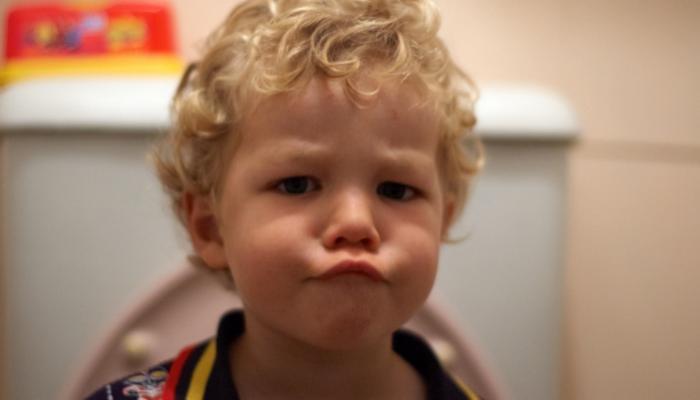
This post may contain affiliate links; please see our terms of use for details.
What two words strike fear into every parent’s heart? POTTY TRAINING!
And this fear is even stronger for parents of stubborn children. You know who you are. Your day is just one argument or power struggle after another and by evening you’re exhausted.
What happens when you add potty training to this equation? It could spell disaster… but if you follow our steps and take your time you’ll be diaper free before you know it!
Beginning Potty Training: The Parent’s Q&A
1. When should I start thinking about potty training?
The worst thing you can do when starting on this journey with a stubborn child is begin the process too early. If they aren’t ready to start, they will not cooperate. Period. The power struggle will be in play right from the get go and even if you stop and take a break for a month, they’ll remember who won this round and will try it again next time. Trust me.
Most children are ready to begin potty training between the age of 2 and slightly after their third birthday, with boys tending to come in later in this time zone. About 50% of boys are trained by age three while 66% of girls are trained by age three. Potty training kids with special needs will most likely take longer.
Don’t try to rush the process by starting when your child is too young. The American Association of Pediatrics reports that kids who begin potty training at 18 months are generally not fully trained until age 4, while kids who begin training at age 2 are generally fully trained by age 3. Many kids will not master bowel movements on the toilet until well into their fourth year.
2. When will I know my child is ready to potty train?
Your child will show you tell-tale signs that they are ready. Here are some things to look for:
- Your child will tell you when their diaper is dirty.
- Your child will tell you right before or while they are going that they are going.
- Their diaper stays dry for about two hours at a time during the day.
- Bowel movements come at regular times.
- Your child will typically stay dry through the night.
- Your child may show an interest in the toilet and an interest in underpants.
- Your child may take off wet diapers themselves because they’re uncomfortable.
- You may notice your child making a face before peeing or pooping.
- You may also notice that your child is more independent, wants to do things for themselves or do them their own way, and probably enjoys some alone time.
Your child is not ready to potty train if they are resistant or afraid of the toilet, have a bowel movement or urinate right after you’ve had them sit on the potty, or wet their diaper in less than two hour intervals.
3. How Long Will it Take?
That completely depends on your child. For most kids you can expect it to be a good two or three months before they are completely potty trained. For others, especially kids with special needs, it could take much, much longer. Take a deep breath, put on your patient hat, and be prepared for lots of accidents.
The Potty Training Shopping List
Being prepared ahead of time will help you gain the upper hand. And it’s always a good idea to be one step ahead of your toddler!
- Potty or training seat: Getting a good potty seat is really key to your success. You want your child to be comfortable and feel safe on the potty. We really love the Baby Björn adjustable potty seat which fits directly on the toilet, but some kids prefer to start out on the floor. In that case, the Baby Björn potty chair is a good choice.
- Step stool: If you’re planning to have your child sit on the toilet with a potty seat, you’ll definitely want a step stool to keep them feeling secure and balanced. Sitting high up on a toilet seat with your legs dangling can feel scary and uncomfortable. A simple step stool can make a world of difference and help your child feel safer in the bathroom.
- Potty training picture books: Throw some potty books on your book shelf and incorporate training into your reading time, too.
- Underpants: Have fun picking out underpants with cartoon characters and bright colors. Make a special trip out of it!
- Training pants: These pants are more absorbent than regular underwear and can pick up little leaks. You can pair them with vinyl pants as a nice in between stage between diapers and underwear.
- Potty training cartoon videos: There are many training videos out there that will help reinforce potty training through cartoons. We love Elmo’s Potty Time.
- Drink and wet doll: Remember how fun you had with these life-like dolls? And they are a great learning tool too!
- Sweatpants and other easy to remove clothing: You’ve probably already got a nice collection of comfort clothes for your child, but if not, now’s the time to pick some up. Of course, some parents opt for the pants-less potty training approach!
Preparing for Potty Training
Stubborn children will sense something is up before you tell them and they will be on their guard. Rather than trying to spring potty training on your child like a sneak attack, involve them in the preparations. Involved kids are more likely to cooperate and less likely to view the whole process as a you-versus-them scenario.
Here are some fun tips to get your little one on your potty training team:
- Have your child help you “train” a doll or stuffed animal. You may want to even consider buying a drink and wet doll with a little toilet so your child can get the whole experience of drinking and then urinating afterwards.
- Go out and have fun buying cool new underwear.
- While still in diapers, have your child begin to help with diapering so that they become more aware of the process. Have them get you a dry diaper, decide where to get changed, pull pants down and up, even help wipe. Talk about what they are doing and begin talking about how soon they will be using the potty.
- Read fun picture books about toilet training.
- When your toddler is still in diapers, don’t change them right away so they can begin to associate a feeling of discomfort with diapers. It will also help them become more involved because they may begin asking you to change their diapers.
- Let them watch you in the bathroom so they know that adults and older siblings use the toilet. Talk about how nice it is to not have to wear diapers. Tell them they will be learning to use the toilet too very soon.
- When you’re really ready to get started, fill a basket with about two or three days worth of diapers and say, “These are the last diapers. When these diapers are gone you’re going to have to use the potty.” This way your child will have a heads up and a very tangible sign that potty training day is coming soon.
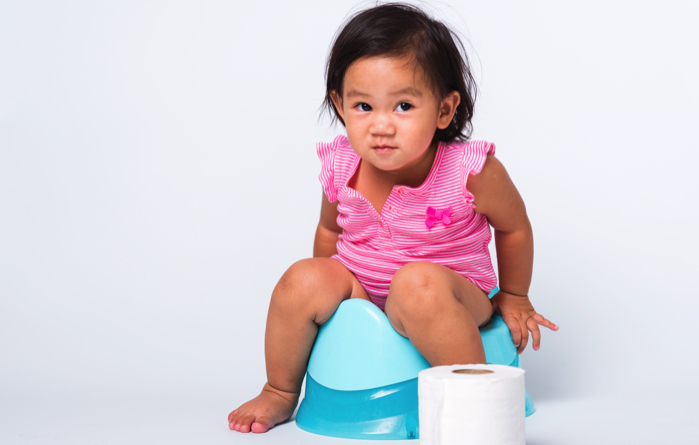
The Step-By-Step Guide to Potty Training
Well, potty training day has finally arrived! Hopefully your little strong-willed toddler is still on board! Now’s the time to take things easy, don’t push too hard, and get out the bleach wipes because you’re going to need them.
Follow these simple tips and you should be crossing diapers off your shopping list in no time:
- Pick a week that you can devote full-time to potty training, like spring break or winter holiday. Don’t start training during a time of stress, especially at the birth of a sibling where kids naturally regress a bit developmentally anyway. If you can mange it, try potty training during the summer when it will be warmer and more comfortable for your toddler to run about with little to no clothing on.
- When it’s time to sit on the potty, don’t ask your child if he has to go potty because the answer will usually be no. Just take him to the potty and sit him on it.
- Sit him on the potty until he goes or for a reasonable amount of time (5 minutes).
- After sitting on the potty, set a timer for 30 minutes if he didn’t potty, 1 hour if he did. Sit on the potty when the timer goes off (this way the timer is the one saying it’s time to sit on the potty, not you).
- Drink lots of fluids.
- Wear underwear and clothes that are easy to get on and off. Many parents potty train their kids with no pants at all just so that they can focus on the potty and not the clothes. If your child is completely naked for potty training (at least on the bottom), accidents will be much more obvious to them. Summer is a great time to potty train because of warmer weather.
- Don’t get upset over accidents (because there will be some). Just clean up and continue with the day. You don’t want your child to become afraid of failure.
- Praise is very important, but make sure you don’t overdo it because this can actually add pressure to the situation, too. You don’t want your child to feel like they’ve let you down when they have an accident.
- Help him relax on the potty. A good way to do this is to come up with a soothing potty song. We sing, “Pee pee, pee pee, it’s time to take a pee pee,” nice and slow and to the tune of “A Tisket a Tasket.”
- Have a reward ready for successful potties. A big glass jar of M&M’s works well because it’s colorful and they can see the prize sitting on the shelf waiting for them. A chart with squares and stickers is good too. Of course, this means that whatever you give as reward in the bathroom has to stay in the bathroom—no M&M’s throughout the rest of the day! Give a reward for sitting on the potty even if they don’t pee, but give a bigger reward if they do pee. Wean off the rewards after a couple of weeks of successful potties. Begin by “forgetting” the treat until your child reminds you—eventually they’ll forget too.
- Continue to wear a diaper to bed for a while or on long outings. Don’t worry about night time dryness while you’re teaching to use the potty during the day.
- Here’s a Fun Tip: Put a couple of drops of food coloring in the potty and tell your child that when she pees it’ll turn the water a different color. Or put cheerios in the potty and see if your son can aim and sink them.
Remember: Relax and take it easy. Your child will learn how to use the toilet, even if they are terribly stubborn. It may take a bit longer and you certainly don’t want to rush or pressure them, but if they’re developmentally ready to potty train, it will happen. Really.
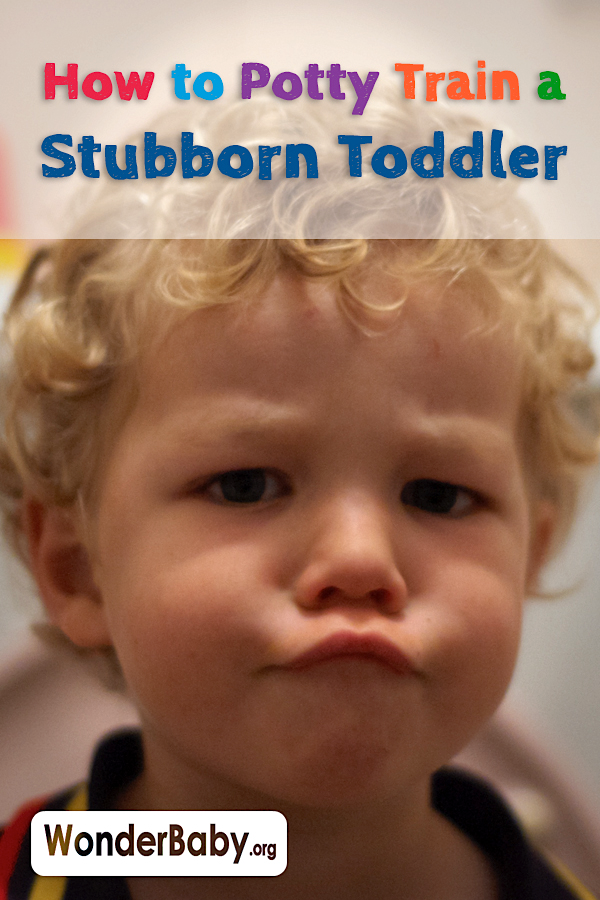
Related Posts
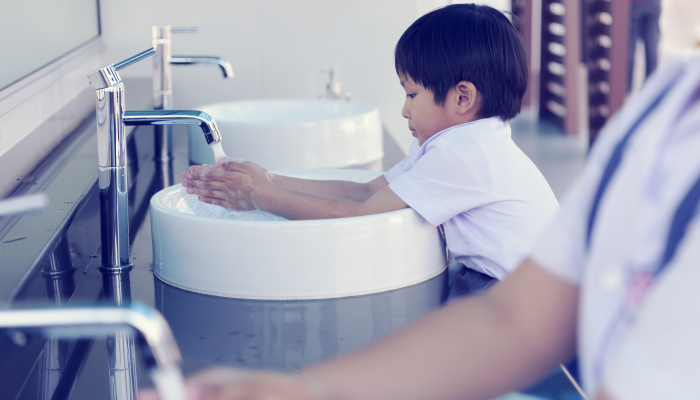
IEPs, Potty Training
7 Sample Toileting IEP Goals
Toileting IEP goals should address the specific needs and abilities of each child. Be flexible and patient as your child works on their toileting skills.
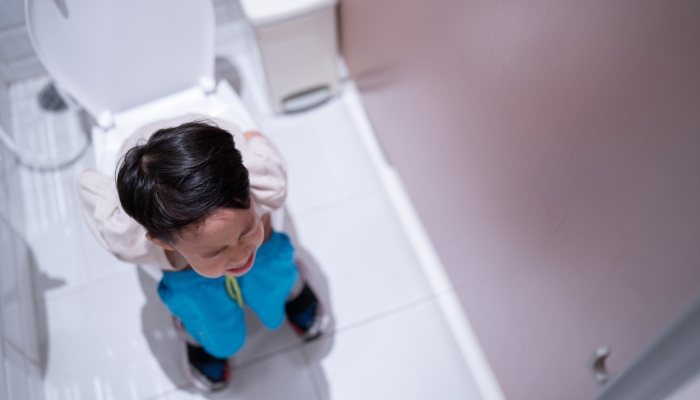
Potty Training
How To Deal With Constipation When Potty Training
Constipation is common amongst children of potty training age. Many children suffer from potty training constipation, but there are things you can do to help.
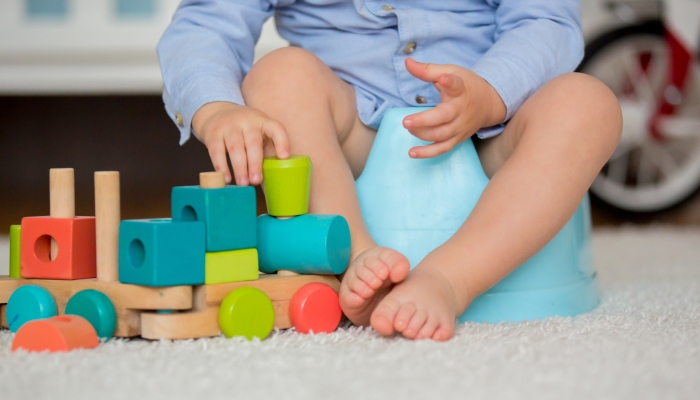
Potty Training
5 Potty Training Games To Make Potty Training Fun
Learning to use the toilet doesn’t have to feel like hard work. There are lots of potty training games you can play with your toddler to make learning fun.